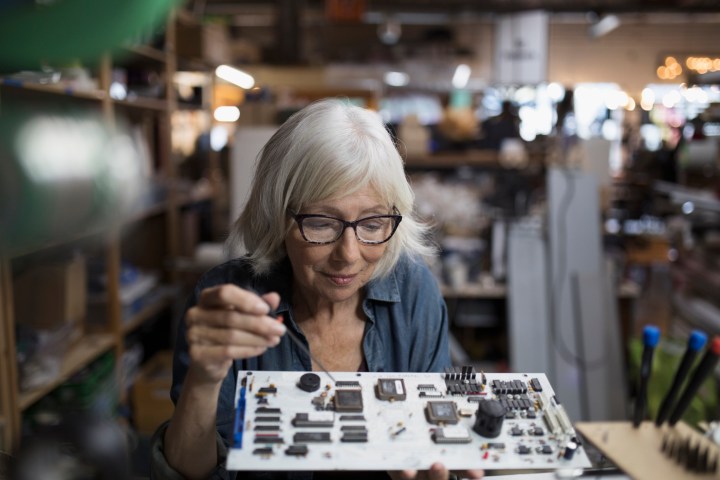
If you browse through Kickstarter today, you might notice something different. On certain projects, you’ll see a little black badge in the lower left, just below the pitch video. These badges say “Hardware Studio,” and while they’re fairly easy to overlook and seemingly insignificant, they’re actually a big step forward not only for Kickstarter, but crowdfunding as a whole.
What these little badges signify is that the project has been accepted into Hardware Studio Connection: a sort of hardware accelerator/manufacturing mentorship program from Avnet and Dragon Innovation — two companies that specialize in electronics and manufacturing, and whom Kickstarter has partnered with. The aim of the initiative is to prevent projects from flopping after they meet their funding goal.
“The reason why we partnered with Avnet and Dragon Innovation is that we wanted to help creators better prepare for manufacturing before they launch a project on Kickstarter,” Julio Terra, head of Kickstarter’s Design and Tech community, tells Digital Trends. “What we’ve learned over the years is that project problems are often recognized after a product is funded, and at that point, it’s often too late to solve the problem because it’s an issue that was caused by decisions that were made very early on in the process.”
Crowdfunding is hard
There are a million things that can go wrong between the successful funding of a campaign and the delivery of the final product to your doorstep. The creator could underestimate the amount of funding they need to finish the project. Manufacturing issues could cause long delays. Hell, sometimes projects fail because creators get too much funding, and don’t know how to scale their production processes and fulfill an unexpectedly large volume of orders. Oftentimes, it’s not that the creator was intentionally trying to scam everyone — it’s just that despite their best efforts, something went wrong.
This is one of the fundamental flaws that has plagued crowdfunding platforms since the beginning. Bringing a product to life is really, really hard, and many creators don’t realize just how complex it is before they dive in and start raising funds. This has led to some very high-profile failures over the years, which aren’t good for anyone involved. When these flops happen, creators are either labeled as fraudsters or incompetent hacks, and backers are left with empty pockets. This is precisely what Hardware Studio Connection aims to fix.

“We’ve been working on this for a long time and we’re really excited that it’s finally now going to be visible to our community at large.” says Terra. “Behind the scenes, together with Avnet and Dragon Innovation, we’ve been working on ways to help our community of backers have a better sense of the manufacturing and readiness of creators on Kickstarter. Once a creator gets accepted into the Connection program, they get these badges, which highlight the project’s level of manufacturing readiness.”
There are four different levels of readiness, each of which comes with a different badge. The first is Engaged, which simply indicates that a project has been accepted into the Hardware Studio Connection program. Then there’s Ready One, Ready Two, and Ready Three. Ready One means the creator has a functional prototype, but still needs to complete some design and engineering work before they can start production. Ready Two badges are for slightly more developed projects. These are given to creators who have done all their engineering and design work, and only need to finalize their certifications and tooling before the’re ready to manufacture. The highest level of readiness, Ready Three, is given to creators who are very far along in the product development process, and can begin manufacturing as soon as they gather up enough money to pay the factory.
Keeping the faith
This system serves two important functions. First and foremost, Hardware Studio Connection helps creators with manufacturing and gives them a better shot at success. Second, it also helps backers make more informed choices when before pledging their support to a project.
“The idea here is that this gives backers a better sense of how ready a creator is when they launch their Kickstarter, and that helps backers make better decisions.” Terra explains. “We know that certain backers are more accepting of risk than others, so this gives them one additional signal to use when determining whether or not they want to support a project.”

More broadly, this initiative also serves a third function: Boosting the public’s faith in crowdfunding — something that’s arguably waned in the past few years as the Kickstarter/Indiegogo graveyard has filled up with Coolest Coolers and Lily drones. With each new flop, faith in the idea of crowdfunding takes a hit. But now that Kickstarter’s Hardware Studio Connection is here, and Indiegogo has rolled out a similar program, it seems that crowdfunding platforms are finally taking steps to address the problem.
“In order for this ecosystem to thrive, there has to be a balance between backers and creators,” says Terra, “and one of the things that we believe creators need to embrace is a certain level of transparency. That’s why, many years ago, Kickstarter made rules requiring creators to feature demos of a working prototype, and also why we prohibited realistic renderings. The Hardware Studio Connection program is different in that it’s an optional thing and it’s something that creators can choose to engage in, but I think it serves a very similar purpose. It’s another step that we’re taking to continue to shore up this foundation of trust that is so crucial for our community to continue to flourish.”




